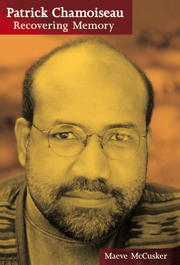Book contents
- Frontmatter
- Contents
- Acknowledgements
- Abbreviations
- Introduction
- 1 Beginnings: The Enigma of Origin
- 2 ‘Une tracée de survie’: Autobiographical Memory
- 3 Memory Re-collected: Witnesses and Words
- 4 Memory Materialized: Traces of the Past
- 5 Flesh Made Word: Traumatic Memory in Biblique des derniers gestes
- Afterword
- Notes
- Bibliography
- Index
2 - ‘Une tracée de survie’: Autobiographical Memory
- Frontmatter
- Contents
- Acknowledgements
- Abbreviations
- Introduction
- 1 Beginnings: The Enigma of Origin
- 2 ‘Une tracée de survie’: Autobiographical Memory
- 3 Memory Re-collected: Witnesses and Words
- 4 Memory Materialized: Traces of the Past
- 5 Flesh Made Word: Traumatic Memory in Biblique des derniers gestes
- Afterword
- Notes
- Bibliography
- Index
Summary
The previous chapter explored the ways in which the absence of any sense of a stable, identifiable beginning, whether historical or mythical, motivates narrative and inflects form in Caribbean fiction, and specifically in Chronique des sept misères. In many ways, the autobiographical impulse expresses much the same need, in that it represents a quest for origins of a particular, but similarly elusive, nature. While, as we will see in later chapters, the elderly fictional protagonist is a privileged source of both the personal and the collective past, Chamoiseau's autobiographies foreground the child as a vector of individual memory, although in both genres the fallibility of testimony is underlined. His triptych of autobiographical narratives (Antan d'enfance, 1990; Chemin-d'école, 1994; A Bout d'enfance, 2005), along with the essay Ecrire en pays dominé (1998), which also has a strongly autobiographical quality, can be seen to have initiated and sustained something of a ‘boom within a boom’ in the French Caribbean: in this same period, most of the major writers from the region (Raphaël Confiant, Gisèle Pineau, Maryse Condé, Daniel Maximin, Ernest Pépin, Emile Ollivier) would produce autobiographies which concentrate on childhood. But in this contemporary burgeoning, Chamoiseau is at once the earliest of practitioners (chronologically, and in terms of age), and the most prolific. It is he who has been most insistently drawn to the genre, and in his work the role and mechanisms of private, intimate, ‘living’ memory are explored on a uniquely extensive scale.
- Type
- Chapter
- Information
- Patrick ChamoiseauRecovering Memory, pp. 47 - 75Publisher: Liverpool University PressPrint publication year: 2011



